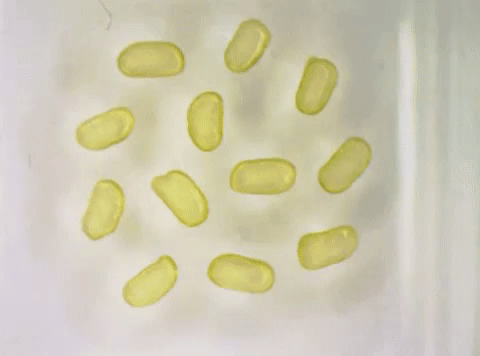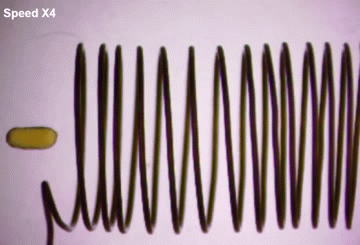A team of scientists from the Lawrence Berkeley National Laboratory, a Department of Energy (DOE) office lab managed by the University of California, have used a modified 3D printer to produce liquid droplets imbued with magnetic properties. Their research, published in the Science journal, could potentially lead to the use of 3D printed devices in a variety of useful and groundbreaking applications due to the combined liquid and magnetic qualities. This could include artificial cells that can deliver targeted cancer therapies, or flexible liquid robots that can change their shape to adapt to their surroundings.
Tom Russell, a visiting faculty scientist at the Berkeley Lab and professor of polymer science and engineering at the University of Massachusetts, Amherst, led the study. Russell also leads a program called Adaptive Interfacial Assemblies Towards Structuring Liquids in Berkeley Lab’s Materials Sciences Division, where for the past seven years he has been developing 3D printable all-liquid structures.
“We’ve made a new material that is both liquid and magnetic. No one has ever observed this before,” explained Russell.
“This opens the door to a new area of science in magnetic soft matter.”
Jamming with 3D printed magnetic liquid
The study is based on an idea formed by Russel and Xubo Liu, a graduate student researcher in Berkeley Lab’s Materials Sciences Division and a doctoral student at the Beijing University of Chemical Technology. The idea centered around forming liquid structures from ferrofluids, which are solutions of iron-oxide particles that gain strong magnetic properties when placed within the presence of another magnet. “We wondered, ‘If a ferrofluid can become temporarily magnetic, what could we do to make it permanently magnetic, and behave like a solid magnet but still look and feel like a liquid?’” commented Russell.
Using a previously developed 3D printing technique, involving a Qidi X-one 3D printer, Russel and Liu 3D printed 1 millimeter droplets from a ferrofluid solution, containing iron-oxide nanoparticles only 20 nanometers in length. Staff scientists Paul Ashby and Brett Helms of Berkeley Lab’s Molecular Foundry revealed that a solid-like shell would develop around nanoparticles at the point of contact between the two liquids, through a phenomenon called “interfacial jamming.” Nanoparticles then begin to gather at the droplet’s surface, “like the walls coming together in a small room jampacked with people,” added Russell.
In order to prescribe magnetic qualities within the droplets of ferrofluid, the scientists placed a magnetic coil in the solution, which pulled the iron-oxide nanoparticles toward it. However, when the coil was removed, the droplets kept their magnetism permanently, while gravitating towards each other in perfect unison, in what the scientists described as an “elegant swirl” or “little dancing droplets.”
Russell was in disbelief regarding their findings, stating that:
“Before our study, people always assumed that permanent magnets could only be made from solids.”

Transferring magnetism between particles
In order to determine the level of magnetism within the droplets, the scientists placed one of them by a magnetic field. After doing so, all of the nanoparticles’ north-south poles responded in unison. Significantly, this was enabled by the ‘interfacial jamming’ of the nanoparticles at the droplet’s surface, which are packed tightly together with only nanometers between each of the nanoparticles, creating the solid surface. There are 1 billion iron-oxide nanoparticles on the droplet’s solid surface, and 70 billion nanoparticles floating around in the droplet’s core.
Upon magnetization, the jammed nanoparticles at the solid surface transfer their magnetic orientation to the particles at the core, thus enabling the whole droplet to become permanently magnetic. The researchers also discovered that divided droplets retained their magnetic properties. The droplets change shape too to adapt to different surroundings – morphing from spherical to cylindrical, and even pancake-like shapes.
Liu and Russell have expressed plans to develop their research further at Berkeley Lab and other national labs, in order to produce increasingly complex 3D printed magnetic liquid structures. “What began as a curious observation ended up opening a new area of science,” added Liu. “It’s something all young researchers dream of, and I was lucky to have the chance to work with a great group of scientists supported by Berkeley Lab’s world-class user facilities to make it a reality.”

3D printed liquid at Berkeley
The technique used to produce droplets of water involved modifying the 3D printer by replacing the print head with a syringe and needle, which extrudes water into a small container of oil placed on the print bed. This technique was used by Berkeley researchers to modify the Qidi X-one 3D printer in 2018, also developed under the Adaptive Interfacial Assemblies Towards Structuring Liquids. It enabled the initial production of 3D printed liquid structures.
As well as using the liquid 3D printing technique to produce liquid-metal devices, researchers at Berkeley have also used the modified system to 3D print an all-liquid device to be used in the chemical synthesis of batteries and drug formulations.
Subscribe to the 3D Printing Industry newsletter for the latest news in additive manufacturing. You can also keep connected by following us on Twitter and liking us on Facebook.
Looking for a career in additive manufacturing? Visit 3D Printing Jobs for a selection of roles in the industry.
Featured image shows spinning liquid magnet, causing dye to swirl. Image via Science Magazine.

